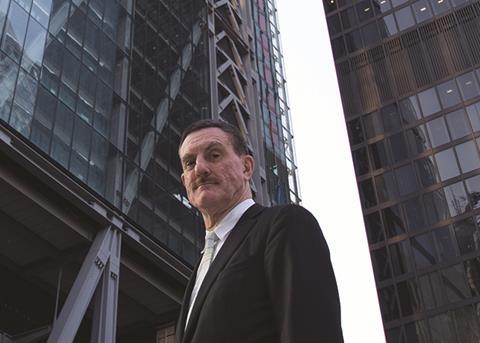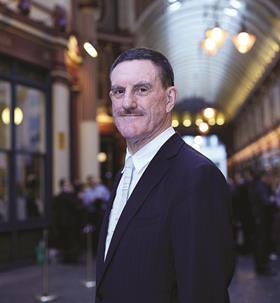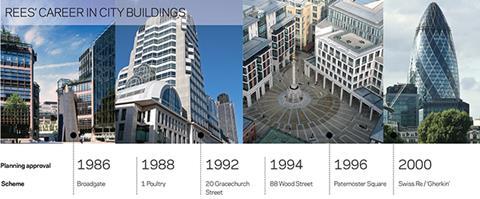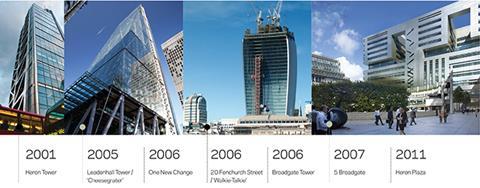Peter Reesā 29 years as head of planning in the Square Mile have been nothing if not controversial. In his first interview since announcing his departure, he talks about transforming the City, his legacy and why his critics are wrong about him

As head of planning in the Square Mile for the past 29 years, Peter Rees has arguably played a larger role in re-shaping Londonās skyline than any other individual in the period. He has overseen development in the City since Margaret Thatcher sparked the Cityās Big Bang through financial deregulation, and worked through three crazy decades of booms and busts.
Like Rees-approved schemes such as the Gherkin, Cheesegrater and Walkie-Talkie, he has towered over the development landscape of the City. The fact is that 78% of the Cityās office space has been renewed under Reesā 29-year tenure.Thousands of developments, including several towers, bear his stamp of approval. Countless more never made it past his desk.
Rees reluctantly passes the reins to his trusted deputy Annie Hampson next month, because his post was axed by City of London Corporation in a restructure - Rees says for cost-cutting reasons. He will join renowned architecture school The Bartlett as a professor.
Architects are like insecure male lovers - desperate to prove something. Engineers are the providers of Viagra
Peter Rees
Rees certainly stamped his authority and colourful personality on the role and, unusually for a planner, gained a larger than life reputation along the way. His tenure did not pass without controversy. He crossed swords with conservationists on multiple occasions - whom he once witheringly branded the āheritage Talibanā - while others criticised the extent of his powers. Uruguayan-born architect Rafael ViƱoly, who is a fan of Rees after he approved his designs for the Walkie-Talkie, nonetheless likened him to Franceās absolutist monarch King Louis XIV for his āform of absolutismā in getting things done in the City. āIt takes one to know one,ā Rees responds drily.
Sat self-consciously on a sofa in the corner of the central courtyard cafe of the Cityās ornate Royal Exchange building, Rees cuts an unlikely tyrant. For all his zinging one-liners, he is not a showman either, or at least not today. Instead - in his first interview since announcing his departure from City Corporation - Rees is humble, thoughtful and passionate. He is keen to take on his critics and to answer the big questions: what does he think his legacy will be and what will happen to the City now that heās moving on?
Legacy
Reesā imminent departure from City Corporation has dismayed the London development industry, which developed an understanding of the trained architectās views and relied on his dependable knack of winning over the City of Londonās planning department and committee. Veteran developer Sir Stuart Lipton, who has worked with Rees on several developments, including the eighties mixed-use Broadgate scheme, is among those sorry to see him go. āThereās nothing wrong with planning when you work with Peter Rees,ā Lipton says. Guy Bransby, head of planning at Jones Lang LaSalle, agrees: āYou knew youād get certainty. What Peter told you was invaluable because his advice didnāt waver. If he was supportive then it took some of the risk out.ā
One aspect of Reesā legacy is the evident success of the Square Mile as a business centre. Tony Travers of the London School of Economics says āthe success of the City compared to other international centresā is in no small part down to its āadaptabilityā under Reesā stewardship. āThe City has been the most adaptable British institution other than the monarchy,ā Travers says. āIt adapted to the Big Bang and now itās adapting to the post-financial-crisis world by becoming an insurance and tech centre. No other world city has been as deftly knocked down and rebuilt.ā
This transformation was partly borne out of necessity as Canary Wharf threatened the Square Mileās supremacy from the nineties onwards. Rees says London āneeds bothā districts, but admits there is still competition between the two. He is theatrically dismissive of Canary Wharf, calling it a āsecond Croydonā and a ātemporary solutionā to āunder supply of office space in the Cityā. He contends that relatively new business districts like Canary Wharf, Croydon, and overseas equivalents like the La DĆ©fense financial district of Paris, will always play second fiddle to the wealth of life, places, boozers and history of the 2,000-year-old City.
This point about life on the streets of the City is key to Reesā thinking on his legacy. It is why heās suggested the Royal Exchange as a meeting place. The 19th-century merchant building was converted into a retail, office and restaurant complex under encouragement from City Corporation and now hums to the rumble of conversation and gossip, like nearby historic Leadenhall Market, which has similarly been restored to accommodate bars and retail. āWeāve tried to bring the party into the City,ā Rees says.

But for many, Reesā legacy will instead be the cluster of tall buildings that has sprouted up in the east of the Square Mile. Contrary to popular belief, City Corporation does not encourage developers to build tall. āThere are two reasons to build tall,ā says Rees. āOne is an inferiority complex, the second is that youāve run out of space. The second is why we build tall in the City. But if you can possibly avoid doing them, donāt do them.ā He jokes development teams are often motivated by inferiority complexes. āArchitects are like insecure male lovers - desperate to prove something. Engineers are the providers of Viagra.ā
He denies an oft-levelled criticism that over-development in the City of London has damaged the cityās historic fabric (). As a former conservation architect, Rees takes the criticism particularly badly. āThe City promotes conservation-led development,ā he says. āThe balance between the two is what makes planning.ā He is unapologetic about historic alleyways that have been overshadowed by towers, such as Love Lane with the Walkie-Talkie. āIn Manhattan you have a cathedral that is surrounded by skyscrapers,ā he says. āI love that kind of contrast.ā
Rees names Broadgate, the Gherkin, the Royal Exchange and revitalised public spaces around St Paulās Cathedral as project highlights from his time at City Corporation. But he admits some howlers have slipped through. Two in particular spring to his mind - an āawfulā office tower block built by Barclays on Gracechurch Street that looks like āmating robotsā and British Landās sprawling Plantation Place development adjacent to the Walkie Talkie on Fenchurch Street, which he regards as āgross over-developmentā. Both got through, he says, against his will, due to political wranglings above his head. Reesā most proud planning victory was the James Stirling-designed No 1 Poultry, which he recommended for approval, only to be defeated at planning committee, before the scheme was dragged through the courts right up to the House of Lords, which ultimately backed Rees.
āLuckily there wasnāt a European court in those days as it was reversed at every step and if it had gone on one more step it probably would have been refused.ā If he has regrets about recent highly contentious approvals - such as the under-construction groundscraper 5 Broadgate for Swiss banking giant UBS or the Walkie Talkie - heās not letting on today. He urges critics to āreserve judgmentā on these projects until theyāre completed.
Pressure-cooker-type situations do not intimidate Rees - in fact, he enjoys them. āI like the excitement and the challenge,ā he enthuses. āI always wanted to be the odd one out. Iām not saying that to boast, Iāve always felt like that, even as a child. Iām a one-off. Iāve never wanted to gain friends and influence people.ā Has he thought about the terms on which he might judge his own legacy? āIf I walk through the City in five to 10 years and itās still changing in a balanced way.ā
The future
Some in the London development community have speculated Reesā departure may have been partly for political reasons, perhaps linked to a perceived strengthening of the City of Londonās planning committee with the recent arrival of a QC and a planning committee member from rival authority the City of Westminster. Rees denies there were political reasons behind his departure. āLike any authority City Corporation has had to make cutbacks,ā he says. Contrary to comment that he ruled the City planning department like an absolute monarch, Rees is keen to acknowledge the āhuge number of people who have been involved in transforming the Cityā and āthe huge team of skilled planners in Guild Hallā for their work over his 29 years there.
As for the future for development in London, Rees is concerned about the prospect of nearly 250 proposed towers being scattered across London in areas such as Nine Elms, Canary Wharf and the South Bank, as forecast by New London Architecture last week. āIām opposed to that if thereās not going to be anything in between them,ā Rees says. āYou must have a strategy. In the City our strategy has been to cluster them in a very small part [the east].ā Contrary to the direction of travel elsewhere, Rees believes the City is āmoving into a very different era, focused on refurbishmentā. He argues many buildings now coming to the end of their working life, or buildings with lease breaks, were built in the eighties and nineties and can be usefully refurbished, perhaps with a new facade, much more sustainably and cheaply than if a developer knocked them down and started again.
As for Rees, he has got over the initial disappointment of leaving the City Corporation, which is actually sponsoring his first year at the Bartlett. In any case he seems tired of playing the role of a gothic villain for the conservation lobby. āItās all very well spending all this time rejuvenating the City, but itās got to the point, like Dr Frankensteinās monster, where I need a bit of it myself. Iām seeing this professorship as some sort of vampiric attempt at rejuventation.ā

























No comments yet